

Daniel Seagren, Jim Henson (hidden), Cooney, and Frank Oz, with Ernie and Bert.

Cooney and Elmo (2005)
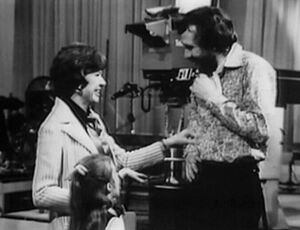
Cooney and Jim Henson
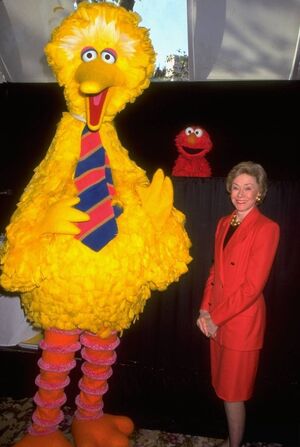
Cooney with Big Bird and Elmo
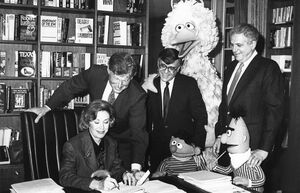
Cooney signing a contract with Random House in 1984.
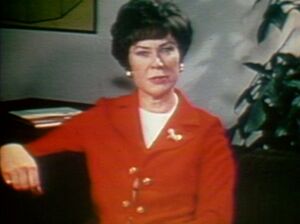
Cooney in the 1969 Sesame Street Pitch Reel.
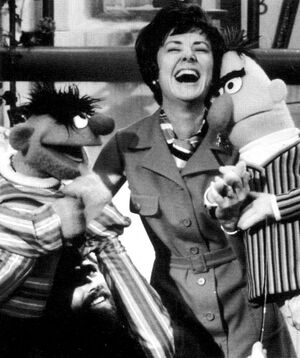
Cooney sharing a laugh with Ernie and Bert.
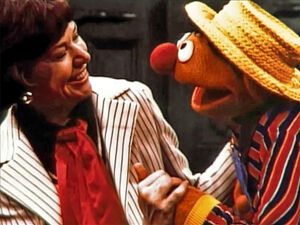
Cooney with Ernie.
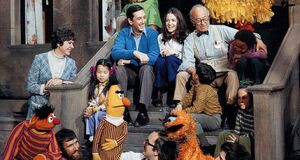
Cooney, with the original Sesame Street cast.
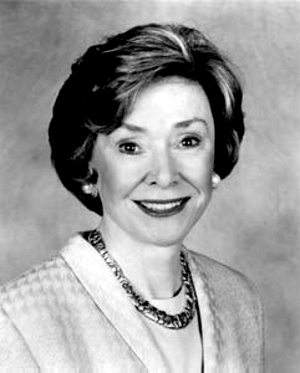
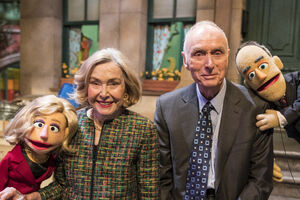
Joan Ganz Cooney and Lloyd Morrisett with Muppet caricatures of themselves at an October 2019 event.
Joan Ganz Cooney (born November 30, 1929 in Phoenix, Arizona) is one of the founders of the Children's Television Workshop (now known as Sesame Workshop). Cooney received her B.A. degree in education from the University of Arizona in 1951.
Childhood[]
Cooney was born Joan Ganz, and adopted the name Joan Redden Ganz, using her mother's maiden name. Cooney went to public school in first grade, switching to Catholic school St. Francis Xavier in Phoenix for grades 2-8. She describes herself then as "just a grim, overwrought little kid." Never able to keep up with her siblings, she always read, much to the chagrin of her mother, who wanted her to get outside.
For high school, Cooney went to North Phoenix, while her siblings went to St. Mary's. She feels this separation, that she was no longer "their little sister," let her come into her own. A participant in school plays and even state-wide drama contests, Cooney was sure she wanted to become an actress. She describes herself as the "world's happiest adolescent," especially after not being a happy child. She says that a psychologist once told her "You're the only patient I've ever had that's ever had a happy adolescence."
One teacher in 1943, Bud Brown, taught a course on the history of culture, as well as operating Bud Brown Barn, a dancing establishment. Brown was Cooney's first teacher to talk about the injustice of segregation, and it "absolutely inflamed" her. Brown talked about Hitler's treatment of the Jews, a topic Cooney says "nobody talked about." "I was 13 years old, and it totally changed my life."
Cooney attended the Catholic girls institution Dominican College, before transferring to the University of Arizona, where she obtained her BA in Education.
Life in New York City[]
Moving to New York City, following stints in newspaper and government work, she was hired in the press department of RCA. There, she wrote regular releases, on prediction of what television would be like in the future, from shopping for groceries, and color transmissions.
She met up with the Arizona-born head of a firm that ran publicity at Pat Weaver's NBC, moving there after eight or nine months at RCA. At NBC, Cooney promoted the daytime drama lineup, consisting of soap operas. As Cooney had started at RCA with a low wage, and transferred within the same company to NBC, her boss wasn't able to raise her income to acceptable levels. He helped Cooney move to publicize The US Steel Hour, which aired on CBS.
Television production[]
When someone from The US Steel Hour left to go to WGBH in Boston, Cooney was shocked to learn that there was a new educational television movement. She instantly knew that she was meant for such an area of broadcasting, "it was like St. Paul on the highway." She wanted to become the publicist for what is now WNET. The head of the station told Cooney he had a publicist, but needed producers. After proving she knew the national issues of the time and pursuing the position through a series of notes, she became a producer for the station.
Her first program was Court of Reason, where two advocates debated, with an audience of three expert judges. Cooney's first documentary produced was Cuba: A Chance at the Beginning. Through this, she met Tim Cooney, who would become her husband. The first episodes focused on adult literacy programs, teenage program Har U in Harlem, and Martin Doutch's program for four-year-olds in Harlem. Head Start was started within months of the third episode airing, and bought 125 prints of the episode to use for teacher training.
Cooney "gave a little dinner party" in 1966 with her then-husband Tim Cooney, Lloyd Morrisett (Vice President of the Carnegie Corporation) and his wife Mary, and Louis Friedman. Carnegie Corporation had been researching children's education; Morrisett was inspired by Friedman's speaking on how the medium of television had not been properly tapped to educate children.
Morrisett called Friedman and Cooney over to the Foundation's offices a few days later. During the meeting, Morrisett and Friedman agreed on creating a study by channel Thirteen, to investigate what reactions would be to such a program. During the meeting, Morrisett mentioned that Cooney wouldn't be interested in such a project, as she was involved in public affairs programming. Cooney remembers yelling back "Oh yes, I would!" Friedman passed her enthusiasm off, as he didn't want to lose her from his crew.
One day, Tim Cooney and Morrisett were having lunch together on a separate matter. Tim suggested to Joan that he mention the project, and Joan agreed, knowing she would never get involved with Friedman in the way. Morrisett eventually convinced Friedman that he wanted Cooney, who went on a three-month leave of absence from documentary production. Cooney toured the United States and Canada, talking to educators, researchers, and television producers. She wrote a paper based on this study, titled The Potential Uses of Television in Preschool Education.
Cooney says that she always knew television could teach, as kids nationwide sang advertisement jingles perfectly from memory, but a paper was needed to make things conclusive and systematic. The paper suggested the basic format of what was to become Sesame Street, along with unused components. The study also motioned for the creation of a children's television production company, to be part of channel Thirteen; she couldn't suggest to her employer that such an organization would be independent. Harold Howe, US Commissioner of Education, liked the findings of the report, and the Ford Foundation soon became interested in such a series.
Children's Television Workshop established[]
Moving to Carnegie, to act and advise independent of Thirteen, Cooney began laying the groundwork for the Children's Television Workshop. Carnegie hired Linda Gotley to help Cooney write the proposal. Barbara Finnburg and Morrisett would regularly act as funders, every few days trying to find holes in the proposal. During these days, segments like "One of these things is not like the other" were established.
Despite the insistence of the US Office of Education that there was no money to fund the project, Howe persisted, and insisted the project be classified as a research project. Ford joined funding, as did the Corporation for Public Broadcasting, which was being established just as Sesame Street was. Between those organizations and Carnegie, $8 million was raised to create a semi-autonomous organization. This organization was established to become completely separate, should they succeed.
At a press conference in March 1968, the Children's Television Workshop and Sesame Street were announced. Jack Gould, television critic for The New York Times gave the project front page space. "If you had Jack Gould in your corner, you could not believe what it meant."
Cooney also served as executive producer on Follow That Bird, the first Sesame Street film. Cooney later stepped down as president of CTW, but is still involved with the series, currently serving as chair of Sesame Workshop's executive committee.
Other[]
Cooney was a cofounder of wowOwow, a mature woman's website, along with Candice Bergen, Joan Juliet Buck, Whoopi Goldberg, Judith Martin, Sheila Nevins, Peggy Noonan, Julia Reed, Liz Smith, Lesley Stahl, Marlo Thomas, Lily Tomlin, Jane Wagner, Mary Wells, and Joni Evans.
Notes[]
- On Sesame Street, Cooney has naturally been referenced a few times:
- In Episode 1090, an airline pilot (played by Jim Thurman) is given the last name Cooney.
- During the credits of Follow That Bird, Count von Count addresses the camera saying "Hi, mom" when Cooney's credit appears onscreen.
- In Episode 2600, when Big Bird and Snuffy announce the "Children's Television Workshop" spiel after the credits, Snuffy asks, "What is that, Bird?", to which Big Bird responds, "Well, I know Joan is one of them."
- In Episode 3395, Ernestine the Telephone Operator receives a call at The Furry Arms Hotel switchboard regarding the production company of the show. After answering the query, Ernestine adds, "I think you should know that by now, Ms. Cooney."
- In Episode 4190, Cooney's name, along with Lloyd Morrisett's, appears on Leela's gardening basket, which boasts the slogan "We Develop Ideas You Grow With."
- Her granddaughter's first words were "Big Bird."[1]
Interviews[]
- The Academy of Television Arts and Sciences Foundation interviewed Cooney for the Archive of American Television. The interview was posted on YouTube in 2008.
- In 2013 she appeared in the German documentary Als die Sesamstrasse nach Deutschland kam ("When Sesame Street Came to Germany"), talking about the international co-production, and the history of Sesame Street in general.
- The 2014 documentary I Am Big Bird: The Caroll Spinney Story features interviews with Ganz Cooney.
- For the 2021 documentary Street Gang: How We Got to Sesame Street, Ganz Cooney was again interviewed extensively.
Sources[]
- ↑ Hellman, Peter. "Street Smart." New York Magazine. November 23, 1987.
- "Archive of American Television Interview with Joan Ganz Cooney," an inteview by Shirley Wershba for the Academy of Television Arts & Sciences Foundation.
